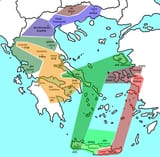Search Results
7/13/2025, 11:50:56 PM
>>17839139
>It is the ancient Greeks who had the biggest impact on the genetic make-up of southern Italy. From the 8th century BCE the Greeks set up colonies all along the coasts of Campania, Calabria, Basilicata, southern Apulia, and Sicily (except the western tip) in what would become known as Magna Graecia. Their genetic signature are essentially haplogroups J2 (18-30%) and E1b1b (15-25%), but the ancient Greeks also carried some R1b-M269/L23 (5-10%), G2a (3-8%), T (1-6%), I2a1b (1-5%), R1a (1-3%), and J1 (1-2%). It is very clear on the haplogroup maps that the areas in central and southern Italy furthest from the coast and from ancient Greek colonies, such as Abruzzo, Molise and the southern Apennines correspond to the highest percentages of haplogroups G2a, J1 and T in Italy, but also the lowest frequency of E1b1b and J2 in the southern half of Italy. There is no better way to contrast the Neolithic population of Italy with the ancient Greek colonists
>In their admixture ratios, Italians are similar to other Southern Europeans of the Mediterranean region, and that is being of primarily Neolithic Early European Farmer ancestry, along with smaller, but still significant, amounts of Mesolithic Western Hunter-Gatherer, Bronze Age Steppe pastoralist (Indo-European speakers) and Chalcolithic or Bronze Age Iranian/Caucasus-related ancestry. According to multiple genome-wide studies, Southern Italians are closest to modern Greeks, while Northern Italians are closest to the Spaniards, the Portuguese, and the Southern French. There is Bronze/Iron Age Middle Eastern and Western Asian admixture in Italy, with a much lower incidence in Northern Italy compared with Central Italy and Southern Italy. North African admixture is also found in Southern Italy with the highest incidence being in the islands of Sicily and Sardinia
>It is the ancient Greeks who had the biggest impact on the genetic make-up of southern Italy. From the 8th century BCE the Greeks set up colonies all along the coasts of Campania, Calabria, Basilicata, southern Apulia, and Sicily (except the western tip) in what would become known as Magna Graecia. Their genetic signature are essentially haplogroups J2 (18-30%) and E1b1b (15-25%), but the ancient Greeks also carried some R1b-M269/L23 (5-10%), G2a (3-8%), T (1-6%), I2a1b (1-5%), R1a (1-3%), and J1 (1-2%). It is very clear on the haplogroup maps that the areas in central and southern Italy furthest from the coast and from ancient Greek colonies, such as Abruzzo, Molise and the southern Apennines correspond to the highest percentages of haplogroups G2a, J1 and T in Italy, but also the lowest frequency of E1b1b and J2 in the southern half of Italy. There is no better way to contrast the Neolithic population of Italy with the ancient Greek colonists
>In their admixture ratios, Italians are similar to other Southern Europeans of the Mediterranean region, and that is being of primarily Neolithic Early European Farmer ancestry, along with smaller, but still significant, amounts of Mesolithic Western Hunter-Gatherer, Bronze Age Steppe pastoralist (Indo-European speakers) and Chalcolithic or Bronze Age Iranian/Caucasus-related ancestry. According to multiple genome-wide studies, Southern Italians are closest to modern Greeks, while Northern Italians are closest to the Spaniards, the Portuguese, and the Southern French. There is Bronze/Iron Age Middle Eastern and Western Asian admixture in Italy, with a much lower incidence in Northern Italy compared with Central Italy and Southern Italy. North African admixture is also found in Southern Italy with the highest incidence being in the islands of Sicily and Sardinia
Page 1
